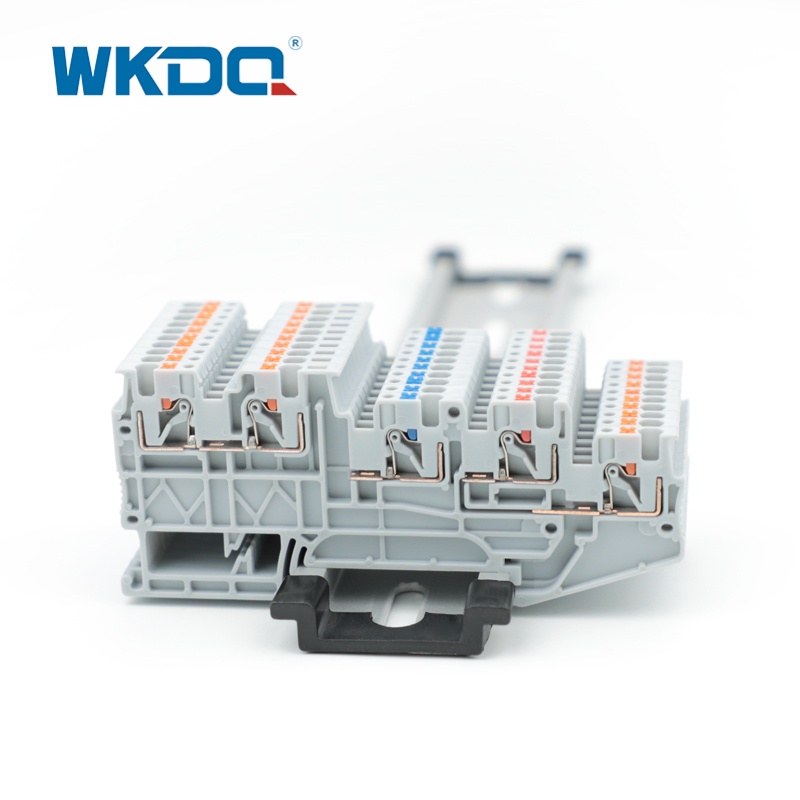Push-In Terminal Block: A Game-Changer in Electrical Connections
2025-04-17
In the world of electrical installations, simplicity, safety, and reliability are essential. Among the various tools and components used to make secure electrical connections, push-in terminal blocks stand out as one of the most innovative and user-friendly solutions. These terminal blocks offer a fast, secure, and efficient way of connecting wires without the need for additional tools or complex procedures. In this blog, we’ll explore what push-in terminal blocks are, how they work, and why they are becoming a popular choice for electrical projects.
What is a Push-In Terminal Block?
A push-in terminal block is a type of electrical connector used to join two or more wires together. Unlike traditional screw terminal blocks, which require a screwdriver to tighten the screws and hold the wire in place, push-in terminal blocks are designed to allow wires to be inserted directly into the connection point, where they are automatically secured by spring-loaded mechanisms. This makes the connection process much faster and eliminates the need for any additional tools.
These blocks are commonly used in various applications, from simple household wiring to more complex industrial systems, providing a quick and reliable way to ensure that electrical connections are made securely.
How Do Push-In Terminal Blocks Work?
The operation of a push-in terminal block is simple and efficient. Here’s how it works:
1. Wire Insertion: The user takes the stripped end of the wire and simply pushes it into the terminal block. There is no need for twisting or crimping the wire.
2. Spring Mechanism: Inside the terminal block, a spring-loaded mechanism automatically grips the wire. This spring action ensures that the wire remains securely in place without the risk of loosening over time.
3. Contacting the Terminal: As the wire is pushed into the block, it makes contact with the terminal, completing the electrical connection. The pressure applied by the spring ensures a stable connection, minimizing resistance and enhancing electrical performance.
4. Removal and Reconnection: If the wire needs to be removed or replaced, it can be done easily by using a release lever or button that is integrated into the terminal block. This lever releases the wire without causing any damage to the terminal or wire, making it ideal for applications that require frequent maintenance or adjustments.
Advantages of Push-In Terminal Blocks
Push-in terminal blocks offer a range of advantages that make them a preferred choice in many electrical applications. Here are some key benefits:
1. Ease of Use: One of the main selling points of push-in terminal blocks is their ease of use. Since there is no need for tools to make the connection, users can complete the wiring process quickly and efficiently. This is especially helpful in situations where speed is essential, such as during the construction or assembly of electrical panels.
2. Time-Saving: With no need for screwing or tightening, push-in terminal blocks significantly reduce installation time. This results in quicker project completion and reduced labor costs.
3. Reliability: The spring mechanism in a push-in terminal block provides a stable and long-lasting connection. Because the wire is securely gripped by the spring, the likelihood of the wire becoming loose due to vibrations, temperature changes, or wear and tear is minimized.
4. No Tool Requirements: Push-in terminal blocks eliminate the need for tools like screwdrivers, crimpers, and wrenches. This makes the entire installation process more straightforward and less prone to human error.
5. Space-Saving: Push-in terminal blocks are compact and often take up less space than traditional terminal blocks with screws. This can be particularly useful in tight electrical panels or when working in environments where space is limited.
6. Reduced Risk of Over-Tightening: With traditional screw terminal blocks, it’s easy to over-tighten the screws, which can damage the wire or the block itself. Push-in terminal blocks avoid this problem, as the spring mechanism ensures the wire is securely held without the risk of excessive pressure.
7. Maintenance-Friendly: If maintenance is required, the ability to quickly disconnect and reconnect wires makes push-in terminal blocks an excellent choice for systems that need to be serviced regularly. The user-friendly release mechanisms allow for easy wire removal and replacement.
Applications of Push-In Terminal Blocks
Push-in terminal blocks are used in a variety of applications where secure, efficient, and reliable electrical connections are necessary. Some of the key areas where these terminal blocks are commonly found include:
1. Electrical Panels: Push-in terminal blocks are widely used in control panels and distribution boards to make quick and secure connections between wires. They are ideal for applications that require high reliability and easy access to connections for future maintenance.
2. Home Wiring: For residential electrical projects, push-in terminal blocks offer a fast and easy way to wire light switches, outlets, and other electrical devices. Their tool-free operation is especially useful for DIY enthusiasts or those working in environments where efficiency is essential.
3. Industrial Machinery: In industrial settings, push-in terminal blocks are used to wire motors, sensors, control systems, and other equipment. The reliability and speed of installation make them a preferred choice for factories and manufacturing facilities.
4. Automation Systems: Push-in terminal blocks are used in automation and control systems where numerous wires need to be connected quickly and securely. These terminal blocks are well-suited for environments that require precision and frequent updates.
5. Transportation and Automotive: Push-in terminal blocks are also used in transportation and automotive industries, particularly for making electrical connections in vehicle systems, electrical equipment, and other electronic components.
Conclusion
Push-in terminal blocks are transforming the way electrical connections are made, offering significant advantages in terms of speed, reliability, and ease of use. Whether you’re a professional electrician, a DIY enthusiast, or working on industrial projects, these terminal blocks offer a tool-free, fast, and secure solution for your wiring needs.
As the demand for efficient and reliable electrical systems continues to grow, push-in terminal blocks are poised to become an indispensable part of modern electrical installations. By saving time, reducing complexity, and ensuring long-lasting performance, they are an excellent investment for anyone involved in electrical work. Whether you are wiring a new construction, upgrading an existing system, or performing regular maintenance, push-in terminal blocks provide the simplicity and efficiency needed for optimal results.



